- Top Employee Onboarding Software
- Why Use Employee Onboarding Software?
- Key Features of Effective Onboarding Software
- How To Choose The Right Onboarding Software?
- Which is the Best Onboarding Software?
- Frequently Asked Questions (FAQs)
- What Is Upskill And Reskill?
- Difference Between Reskilling And Upskilling
- Upskilling for Workplace Advancement
- Reskilling for Career Transformation
- Crafting Successful Upskill and Reskill Strategies
- Upskill And Reskill Strategizing: Things to Keep in Mind
- Measuring the Impact of Skill Development Initiatives
- Frequently Asked Questions
- What’s a Skill Gap?
- Employee Skill Gap Analysis: Why Do We Need It?
- How To Conduct Employee Skill Gap Analysis?
- Addressing Skill Gaps Through Training and Hiring
- Utilizing Skills Gap Analysis for Strategic Planning
- Leveraging Employee Skill Gap Analysis: Things To Keep In Mind
- Frequently Asked Questions
- Transformative Role of AI in Talent Acquisition
- Impact of AI on Business Recruiting
- Overcoming Challenges in AI-Driven Talent Acquisition
- Starting with AI in Talent Acquisition
- Future Landscape of AI in Talent Acquisition
- Frequently Asked Questions
- HR In The Hot Seat - Challenges With Evolving Workforce
- Mastering Effective HR Management: Tips For Overcoming Challenges
- Summing Up
- The Future of HR: Key Trends for 2024
- Skill-Based Hiring
- Prioritizing Employee Experience, Engagement & Well-being
- AI-Empowered Workforce Evolution and Its Impact
- Taking Diversity, Equity, and Inclusion Beyond Mandates
- Hybrid and Remote Work
- Embracing the Gig Economy and Blended Workforce
- Transparent HR Practices
- Climate Change Adaptation in HR Practices
- Leveraging HR Analytics for Data-Driven Decisions
- Continuous Learning & Development to Improve Productivity
- The Office Buzz in 2024
- Bottom Line - HR Operating Model Needs A Shift
- Importance and Impact of Recognizing Employee Birthdays
- Professional Birthday Wishes for Employees (All Experience Levels)
- Personalized Birthday Wishes for Employees in Different Roles
- Fun Birthday Wishes for Employees (with Templates)
- Birthday Wishes for Remote Employees
- Heartfelt Birthday Wishes for Employees
- Belated Birthday Wishes for Employees
- Simple & Sweet Birthday Wishes for Employees
- Celebrating Employee Birthdays: Ideas and Traditions
- Tips and Ideas for Sending Birthday Wishes to Employees
- Closing Thoughts
- Frequently Asked Questions
- What Is An Employee Referral?
- Benefits of Implementing Employee Referral Programs
- Setting Up an Effective Employee Referral Program
- Employee Referral Email
- Employee Referral Scheme
- Overcoming Challenges of Employee Referrals
- Companies with Best Employee Referral Programs
- Employee Referral Programs: Best Practices
- Closing Thoughts
- Frequently Asked Questions (FAQs)
- Importance of Team Building Activities
- Types of Team Building Activities
- Outdoor Team Building Activities for Employees
- Indoor Team Building Activities for Employees
- Easy Team Building Activities for Remote Employees
- Team Building Activities For New Employees (Icebreakers)
- Fun Team Building Activities for Different Goals
- To Boost Communication and Collaboration
- To Reduce Stress Levels and Promote Well-being
- Aligning Team Purpose and Values with Strategic Activities
- Final Remarks
- Frequently Asked Questions
- Importance of Employee Appreciation Quotes
- Work Appreciation Quotes for Employees
- Employee Appreciation Quotes for Hard Work Recognition
- Employee Appreciation Quotes for Teamwork and Collaboration
- Appreciation Quotes for Celebrating Employee Anniversaries and Milestones
- Employee Appreciation Quotes for Strong Work Ethics
- Employee Appreciation Quotes for Project & Goal Completion
- Employee Appreciation Quotes for Quality of Work
- Employee Appreciation Quotes for Creativity and Innovation
- Appreciation Quotes for Managers
- Peer-to-Peer Employee Appreciation Quotes
- Appreciation Quotes for Employees Leaving the Company
- Employee Appreciation Quotes for Thoughtful Gestures
- Funny Employee Appreciation Quotes
- Short Employee Appreciation Quotes
- Employee Appreciation Quotes for Different Roles
- Employee Appreciation Quotes for Senior Leadership
- Creative Ways to Use Employee Appreciation Quotes
- Summary
- Frequently Asked Questions (FAQs)
- What is Employee Satisfaction?
- Importance of Employee Satisfaction
- Objectives of Employee Satisfaction
- Employee Satisfaction vs. Employee Engagement
- Key Reasons for Employee Dissatisfaction
- Strategies for Improving Employee Satisfaction
- Ways to Measure Employee Satisfaction
- Best Practices for High Employee Satisfaction
- Final Remarks
- Frequently Asked Questions (FAQs)
- How to Craft Effective Employee Appraisal Comments
- Key Areas to Focus in Performance Review
- Comments On Hard Work & Dedication
- Assessing Interpersonal Skills
- Evaluating the Ability to Collaborate & Work in Teams
- Gauging Punctuality
- Commenting on Communication Style
- Reviewing Time Management and Productivity
- Leadership in Performance Appraisals
- Assessing Creativity & Innovation
- Evaluating Problem-Solving Abilities
- Recognizing Flexibility and Dependability in Reviews
- Employee Appraisal Comments for Different Roles
- Summary
- Frequently Asked Questions (FAQs)
- Employee Grievance Meaning
- Importance of Employee Grievance Process
- Types of Workplace Grievances
- Reasons for Employee Grievances
- Employee Grievance Procedure
- Steps in the Employee Grievance Handling Process
- Employee Grievance Form Example
- Final Remarks
- Frequently Asked Questions (FAQs)
- What is Company Culture?
- Importance of Company Culture
- Types of Company Culture
- Factors Contributing to Organizational Culture
- Assessing & Developing Corporate Culture
- Company Culture - It’s not just Perks or Feels
- Good Company Culture Examples
- Developing Company Culture: Best Practices
- Closing Thoughts
- Frequently Asked Questions (FAQs)
- What is Employee Empowerment?
- Benefits of Empowering Employees
- Employee Empowerment vs. Micromanagement
- Strategies for Effective Employee Empowerment
- Role of Managers in Fostering Empowerment
- Organizational Structure Supporting Empowerment
- Overcoming Barriers to Employee Empowerment
- Frequently Asked Questions (FAQs)
- What is Employer Branding?
- Importance of Employer Branding Strategy
- How to Build an Employer Branding Strategy?
- Strategies for Building a Strong Employer Brand
- How to Measure and Boost Your Employer Branding Success?
- Examples of Strong Employer Brand Strategy
- Best Practices for an Effective Employer Branding Strategy
- Closing Thoughts
- Frequently Asked Questions (FAQs)
- What are Employee Wellness Programs?
- Importance of Employee Wellness Programs
- Examples of Employee Wellness Programs
- Real-Life Examples of Corporate Wellness Programs
- Strategies for Encouraging Participation
- Supporting Diverse Employee Needs
- Creating Comprehensive Wellness Programs
- Measuring the Impact on Business and Employees
- Closing Thoughts
- Frequently Asked Questions (FAQs)
- What is Talent Management?
- Developing a Winning Talent Management Strategy
- Models and Frameworks
- Tips for Framing Effective Talent Management Strategy
- Looking Ahead: Recent Trends in Talent Management
- Frequently Asked Questions
- Role of AI in HR: Addressing Common Challenges
- Artificial Intelligence in HR Processes
- AI Tools for HR Functions
- How to Adopt AI in HR?
- Addressing Challenges of AI in HR
- Ethical and Responsible AI Use
- The Future of AI in HR
- Closing Thoughts
- Frequently Asked Questions
- What is Performance Management?
- Elements of Effective Performance Management
- Performance Management Cycle
- Differentiating Performance Management
- Benefits of Performance Management With Examples
- Challenges faced in Performance Management and their Solutions
- Future Trends in Performance Management
- Frequently Asked Questions
- Changing Role of HRM
- Changing Role Of HR Manager
- Technology and the Changing Role of HRM
- The Rise of AI and Machine Learning in HR
- Mobile Technology's Impact on HR Practices
- The Significance of People Analytics in HR
- Navigating the Future of HR Technology
- Final Remarks
- Frequently Asked Questions
- Compensation Management Meaning
- Compensation Types
- Breaking Down The Compensation Management Process
- HR Software for Compensation Management
- Current Trends in Compensation Management
- Frequently Asked Questions
- Defining Flexible Work Arrangements
- Flexible Working: Advantages for Businesses
- Challenges of Flexible Work Arrangements
- Crafting Flexible Working Practices
- Types Of Flexible Work Arrangements
- Comparing Flexible Work Arrangements
- Real-Life Examples of Flexible Work Arrangements
- Final Remarks
- Frequently Asked Questions
- Conflict Resolution Meaning
- Conflict Origins
- Tried & Tested Conflict Resolution Strategies
- Methods of Conflict Management at Workplaces
- Conflict Resolution Strategies: Top Management Tips
- Summary
- Frequently Asked Questions
- Career Development Meaning
- Career Development Plan for Employees
- Career Development in HRM: Growth Ideas For Employees
- Issues in Career Development and Their Solutions
- Closing Thoughts
- Frequently Asked Questions
- Understanding Compensation
- Exploring Benefits
- Difference between Compensation and Benefits
- Compensation & Benefits Structure
- Final Remarks
- Frequently Asked Questions
- Defining Recruitment in HR Practices
- Exploring Talent Acquisition in HR
- Understanding Talent Acquisition vs Recruitment
- When to Recruit or Acquire Talent
- Talent Acquisition vs Recruitment: Responsibilities
- From Recruitment To Talent Acquisition
- Closing Thoughts
- Frequently Asked Questions
- Work Culture Meaning
- Types of Work Cultures
- Components of Culture
- Best Work Culture Examples Set By Top Companies
- Creating a Positive Work Culture
- Closing Thoughts
- Frequently Asked Questions
- Defining Learning vs Development
- Importance of Learning and Development
- L&D Activities for Employees
- Choosing the Right L&D Activities
- Crafting an Effective L&D Strategies
- Aligning L&D Strategy with Business Goals
- Designing Engaging Learning Journeys
- Learning and Development Process: KPIs
- ROI in Learning and Development
- Emerging Trends in L&D
- Closing Thoughts
- Frequently Asked Questions
- What Is Leadership Development?
- Key Skills for Leaders
- How To Develop Leadership Skills in Organizations?
- What Is A Leadership Development Program?
- How To Develop A Leadership Development Program?
- Example of A Leadership Development Plan
- Benefits of Leadership Development Training
- Frequently Asked Questions
- Defining Diversity Training
- Importance of Diversity Training
- What are the Types of Diversity?
- Types of Diversity Training Methods
- Diversity Training Activities
- Choosing A Diversity Training Program
- How to Implement Diversity Initiatives
- Best Diversity Training Programs (Real-Life Examples)
- Improving the Effectiveness of Diversity Training
- Tracking and Evaluating the Results of DE&I Training Efforts
- Essential Elements for Successful Diversity Training
- Closing Thoughts
- Frequently Asked Questions
- Defining Occupational Health & Safety
- Evolution of Workplace Health and Safety
- Identifying Common Workplace Hazards
- Global Impact on Occupational Health & Safety
- Managing Employee Health and Safety Risks
- Occupational Health and Safety Problems
- Future of Occupational Health and Safety
- Frequently Asked Questions
- Employee Orientation Defined
- Employee Onboarding Explained
- Orientation and Onboarding: Understanding the Difference
- Importance of Orientation and Onboarding
- Crafting Comprehensive Integration Strategies
- Quick Tips for Orientation and Onboarding
- Frequently Asked Questions
- What is HR Metrics?
- Importance of HR Metrics
- HR Metrics Examples in Recruitment
- HR Metrics Examples in Employee Retention
- HR Metrics Examples in Revenue
- Other Common HR Metrics
- Soft HR Metrics Example
- HR Metrics Formula
- Utilizing HR Metrics Effectively
- Future of HR Metrics
- Summary
- Frequently Asked Questions
- Defining Decision Making Process
- Key Concepts In Decision Making
- Decision Making & Problem Solving
- Tips For Improving Decision Making Skills
- Selected Practice Questions & Answers
- Conclusion
- Frequently Asked Questions (FAQs)
- A case(s) of miscommunication
- The devil is in the (resume) details
- One for the complaints!
- What is an Exit Interview?
- Benefits of Exit Interviews to an Organization
- How to Conduct Exit Interviews?
- Exit Interview: Sample Questions to Ask
- Overcoming Challenges of Exit Interviews
- Exit Interviews: Best Practices
- Closing Thoughts
- Frequently Asked Questions
- Technology in the Workplace
- Benefits of Tech Integration
- Technology in the Workplace: Key Functions
- How Technology Normalized Remote Work
- Workplace Technology: Top Tools and Software
- Steps for Effective Technology Implementation
- Overcoming Tech Implementation Challenges
- Ethical Considerations in Tech Use
- Keeping Pace with Tech Trends
- Closing Thoughts
- Frequently Asked Questions
- What is Ethical Leadership?
- Principles of Ethical Leadership
- Difference between Ethics and Integrity
- Importance of Ethical Leadership
- Ethical Leadership in Practice
- Overcoming Challenges
- Frequently Asked Questions
- Embracing Change Management
- Mastering People Analytics
- Enhancing Stakeholder Relationships
- Navigating Diversity, Equity & Inclusion
- Upholding Ethics and Data Privacy
- Developing Critical Thinking
- Advancing Negotiation Techniques
- Fostering Inter-departmental Collaboration
- Building Resilience in HR
- Frequently Asked Questions
- What is Mental Health?
- Benefits of a Mentally Healthy Workforce
- Prioritising Mental Health: Creating a Culture of Support
- Final Remarks
- Frequently Asked Questions
- Gen Z vs Millennials - What is the difference?
- Retain and Engage Gen Z Employees: Need and Strategies
- Strategies to Retain and Engage Gen Z Employees
- Rethinking Requirements
- Final Remarks
- Frequently Asked Questions
- Understanding Millennial Leadership Needs
- Key Leadership Skills for Millennials
- How To Develop Millennial Into Leaders
- Additional Strategies to Develop Leaders
- Learning Preferences of Millennials
- Benefits of Investing in Millennial Leaders
- Closing Thoughts
- Frequently Asked Questions
- Understanding Fluff
- Examples of Interview Fluff
- Identifying Interview Fluff
- Addressing Interview Fluff
- Seeing Through the Fluff
- Frequently Asked Questions
- What is the Gender Pay Gap?
- Is the Gender Pay Gap Real?
- Factors Affecting the Gender Pay Gap
- How Age Impacts Women’s Earnings
- The ‘Motherhood Penalty’
- Education's Role in Wage Differences
- Racial and Ethnic Disparities in Pay
- Closing the Gender Gap
- Frequently Asked Questions
- Top Weirdest Late-To-The-Office Excuses
- The Fine Art of Balancing Wit and Wisdom in HR
- Understanding Social Media Recruiting
- Crafting Your Social Media Recruitment Strategy
- Implementing Your Strategy Effectively
- Popular Platforms for Recruitment
- Navigating the Downsides of Social Media Recruiting
- Measuring Success and Adjusting Strategy
- Summary
- Frequently Asked Questions
- Who Is A High Potential (HIPO) Employee?
- Characteristics of A High Potential (HIPO) Employee
- High Potential Employee Identification
- Grooming High Potential Employees
- Why High Potential Employees Leave
- How Do You Retain High Potential Employees?
- High Potential Employee Development: Best Practices
- Closing Thoughts
- Frequently Asked Questions
- What is Digital Fluency?
- Why Digital Fluency Matters?
- Difference between Digital Literacy and Digital Fluency
- Key Components of Digital Fluency
- Achieving Digital Fluency
- Overcoming Challenges
- Future of Workforce Digital Fluency
- Frequently Asked Questions
- What is Loud Quitting?
- Pros and Cons of Loud Quitting
- Reasons Behind the Trend
- Analyzing the Impact
- How HR Can Navigate the Loud Quitting Uproar
- Preventive Strategies
- Closing Thoughts
- Frequently Asked Questions
- Defining Emotional Intelligence in HR
- Why Emotional Intelligence Matters for HR Leaders
- How To Build Emotional Intelligence in HR
- Integrating EQ into HR Practices
- Impact of EQ on Company Culture
- Emotional Intelligence in HR: Major Challenges
- Final Remarks
- Frequently Asked Questions
- Understanding Internal Job Posting
- Internal Job Posting: Pros and Cons
- The Internal Job Posting Process
- Writing Effective Ads for Internal Job Posting
- Strategies for Success of Internal Job Posting
- Summary
- Frequently Asked Questions
- Understanding Workplace Bias
- Common Types of Bias in HR
- Closing Thoughts
- Frequently Asked Questions
- What is a Dry Promotion?
- Dry Promotion: Pros and Cons for Companies
- Impact of Dry Promotion on Employee Retention
- Preventing Talent Loss After Dry Promotions
- Closing Thoughts
- Frequently Asked Questions
- What Is A Stay Interview?
- Importance Of Stay Interviews
- Benefits And Challenges Of Stay Interviews
- Planning And Conducting Stay Interviews
- Stay Interviews: 20 Sample Questions To Ask
- Best Practices For Effective Stay Interviews
- Summary
- Frequently Asked Questions
- Who Is A Boomerang Employee?
- Reasons For Returning
- Benefits Of Hiring Boomerang Employees
- Challenges Of Rehiring
- Interviewing Boomerang Candidates: Sample Questions
- Enhancing The Hiring Process
- Making Informed Decisions
- Final Remarks
- Frequently Asked Questions
- Talent Pipeline Meaning
- Significance of Talent Pipelines
- Advantages of a Talent Pipeline
- Building a Talent Pipeline
- Maintaining a Talent Pipeline
- Attracting Top Talent
- Implementing the Strategy
- Frequently Asked Questions
- What is Micromanagement?
- Recognizing Micromanagement
- Leadership versus Micromanagement
- Keeping Micromanagement in Check
- Beyond Micromanagement
- Summing Up
- Frequently Asked Questions
- Recognizing Signs Of A Bad Hire
- Understanding The Impact On Teams
- Dealing With A Bad Hire
- Preventing Future Bad Hires
- Closing Thoughts
- Frequently Asked Questions
- Defining Neurodiversity
- Importance of Neurodiversity in the Workplace
- Moving Towards Inclusive Environments
- Final Remarks
- Frequently Asked Questions
- Understanding the Generation Gap
- Multigenerational Workforce: Debunking Stereotypes
- Strategies for Bridging the Gap
- Benefits of a Multigenerational Workforce
- Final Remarks
- Frequently Asked Questions
- Defining Productivity Theatre: All Show, No Go
- 5 Key Drivers of Fake Productivity
- Solutions to Combat Productivity Theatre
- Summary
- Frequently Asked Questions
- Defining Grumpy Staying
- Why do Grumpy Stayers not Leave?
- Recognizing the Signs
- Exploring the Causes
- Understanding the Impact
- Addressing the Issue
- Taking Action: Addressing Grumpiness with Empathy
- After the Conversation
- When Grumpy Staying Continues
- Closing Thoughts
- Frequently Asked Questions
- The Rationale Behind Office Peacocking
- Impact on Company Culture
- Impact on Employees
- Case Studies: Examples of Office Peacocking
- The Downside: Potential Pitfalls of Office Peacocking
- Practical Tips for Implementing Office Peacocking
- Frequently Asked Questions
- 13 Common Mistakes Young Managers Make
- Strategies To Avoid Mistakes (Individual Growth)
- How Young Managers Can Boost Teamwork
- Learning From Errors
- Summary
- Frequently Asked Questions
- Understanding Great Regret - What causes the shift shock?
- Impact of Great Regret
- How can HR help make the situation better?
- Closing Thoughts
- Frequently Asked Questions
- Understanding the HR Budget
- Key Components of an HR Budget
- Preparing an HR Budget Step-by-Step
- Importance of HR Budgeting in Management
- Final Remarks
- Frequently Asked Questions
- What are Pre-Employment Assessments?
- Importance of Pre-Employment Testing
- Types of Pre-Employment Assessments
- 15 Tips for Creating Effective Pre-Employment Assessments
- Closing Thoughts
- Frequently Asked Questions
- Exploring the Productivity Paradox
- Understanding the Impact of Solow Paradox
- Productivity Paradox: Why it Matters for Recruiters & HRs
- Identifying Causes and Challenges
- Strategies for Enhancing Productivity
- AI & the Modern-Day Productivity Paradox
- Beyond Technology: Building a Productive Workforce
- Summary
- Frequently Asked Questions
- Understanding the Great Reshuffle 2.0
- Preparing Leaders for the Change
- HR’s Role in Handling Great Reshuffling 2.0
- The Way Ahead
- Frequently Asked Questions
- Definition Of Managerial Grid
- Managerial Grid Theory Explained
- Application Of Managerial Grid
- Criticisms And Limitations
- Evolution And Contemporary Perspectives
- Integrating Managerial Grid With Other Models
- Practical Steps For Implementing Managerial Grid
- Conclusion
- Frequently Asked Questions
- Understanding Skills Taxonomy
- Why do we Need Skills Taxonomy?
- Benefits of Skills Taxonomy
- Components of Skills Taxonomy
- Building a Skills Taxonomy: A Step-by-Step Guide
- Skill Taxonomies vs Intelligence Tools
- Closing Thoughts
- Frequently Asked Questions
- Definition Of Team Building
- Stages Of Team Development
- Top 10 Strategies For Effective Team Building
- Team Building Activities
- Best Practices For Effective Team Building
- Setting Team Building Objectives
- Challenges In Team Building
- Conclusion
- Frequently Asked Questions (FAQs)
- Defining Job Shadowing
- Unpacking the Benefits
- Setting Up the Experience
- Job Shadowing vs Internship
- Dos and Don'ts for HR Professionals
- Closing Thoughts
- Frequently Asked Questions
- Employee Journey Mapping: Meaning & Importance
- Stages of the Employee Journey
- Steps for Effective Mapping
- Employee Journey Map: Where does it begin?
- Employee Journey Map: Template
- Best Practices & Tips
- Summary
- Frequently Asked Questions
- Why are Performance Appraisals needed?
- Evolution of Performance Management
- Modern Performance Practices
- Benefits of Modern Performance Appraisals
- The Future
- Frequently Asked Questions
- Is Experience the Sole Indicator of Success?
- Why Hire Inexperienced Talent?: Key Advantages
- Skills to Look For in Inexperienced Talent
- Challenges and Considerations in Hiring Inexperienced Talent
- Final Remarks
- Frequently Asked Questions
- What is a Company Retreat?
- Company Retreat Ideas: Team-Building & Exploration
- Relaxation and Celebration
- Planning Your Retreat: Things to Keep in Mind
- Closing Thoughts
- Frequently Asked Questions
- Understanding HR Forecasting
- HR Forecasting Key Concepts
- Steps for Implementing HR Forecasting
- Common HR Forecasting Methods
- Closing Thoughts
- Frequently Asked Questions
- What is ESG?
- HR and ESG - Why Care?
- ESG in HR Strategy
- Challenges for HR
- Future of ESG in HR
- Frequently Asked Questions
- Defining the Great Betrayal
- Reasons for Its Spread
- Impact on Workers
- Impact on Corporations
- Rebuilding Trust & Valuing Employees
- Closing Thoughts
- Frequently Asked Questions
- Importance of Clear Expectations
- Setting Expectations Early
- Communicating Expectations Effectively
- Differentiating Expectations
- Reviewing and Adjusting Expectations
- Summing Up
- Frequently Asked Questions
- Understanding KRA Frameworks And Models
- KRAs vs KPAs and KPIs
- Monitoring and Tracking KRAs
- KRAs in Various Roles
- Impact of KRA Frameworks and Models on Organizational Success
- Frequently Asked Questions
- Where: The Place of Work
- When: The Time of Work
- How Much Work: Alternate Employment Models
- Who Does the Work: Intelligence
- Designing Organizations with the Four Dimensions of Work
- Summing Up
- Simplifying Processes: The Foundation of Efficiency
- Reducing Unnecessary Meetings: Reclaiming Valuable Time
- Building Strong Accountabilities: Ensuring Responsibility
- Role of HR in Addressing Inefficiencies
- Continuous Improvement: A Commitment to Excellence
- Leadership's Role in Driving Efficiency
- Conclusion: A Holistic Approach to Efficiency
- Understanding Financial Freedom
- Benefits of Empowering Employees Financially
- Empowering Employees Through Financial Literacy
- Financial Topics That Need Attention Based On Career Stage
- Summing Up
- Frequently Asked Questions
- Defining Employee Voice
- Benefits of Amplifying Employee Voice
- Strategies and Tools
- Encouraging Participation
- Closing Thoughts
- Frequently Asked Questions
- Appraisal Blues: Signs of Unhappy Employees
- Addressing Unhappiness Post-Appraisal
- Non-Monetary Solutions for Dissatisfied Employees
- Summing Up
- Frequently Asked Questions
- Women in the Middle Eastern Workforce
- Importance of DEIB
- Role of HR in Building Inclusive Workplaces for Women
- Measuring Inclusion Progress: Key Metrics
- Closing Thoughts
- Frequently Asked Questions
- Preparing for the Conversation
- Conducting the Conversation
- Best Practices for the Talk
- After the Conversation
- Helping Employees Grow
- Frequently Asked Questions
- Understanding HR Exhaustion
- Factors Leading To HR burnout
- Impact Of HR Burnout
- Strategies To Prevent And Manage HR Burnout
- Role Of Technology In Preventing Burnout
- Celebrating HR Successes
- Summary
- Frequently Asked Questions
- Common Mistakes When Hiring Young Talent
- Building Connections with Candidates
- Summary
- Frequently Asked Questions
- Walking a mile in the employee’s shoes
- Conducting Humane Layoffs
- Remote Layoffs Management
- Supporting Laid-off Workers
- Managing the Aftermath
- Wrapping Up
- Frequently Asked Questions
- Importance of Shortening Time-to-Hire
- Shortening Hiring Time: Pre-Application Stage
- Reducing Hiring Time: Application Stage
- Hacks to Shorten Hiring Time: Interview Stage
- Reducing Hiring Time: Offer Stage
- 5 Other Important Hacks & Strategies
- Final Remarks
- Frequently Asked Questions
Employee Satisfaction: Uncovering Its Importance & Strategies
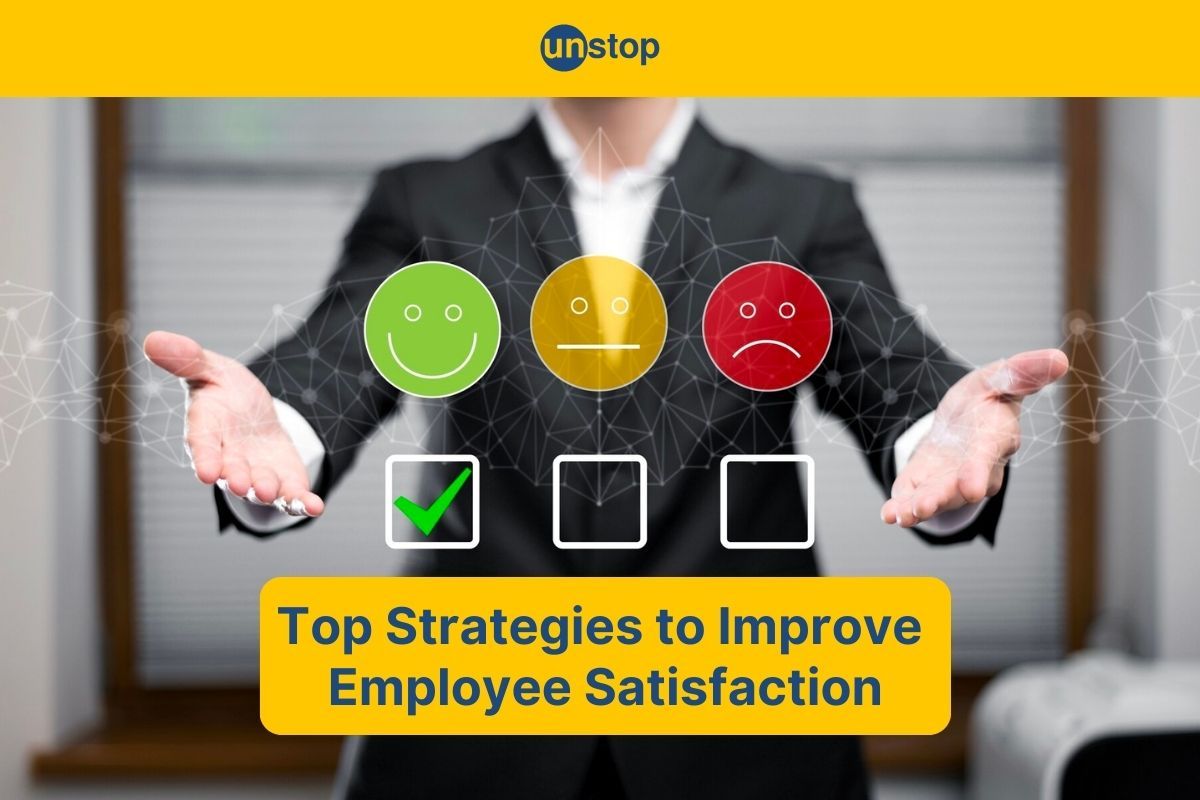
It doesn’t take a genius to know that happy employees are more engaged, motivated, and likely to stay with an organization long-term. No wonder companies that prioritize employee satisfaction often experience higher retention rates and increased productivity levels.
Over the years, as the workforce changed, employee satisfaction also transformed. A fat paycheck is still important - but it’s no longer the only factor influencing employees’ happiness. A good work environment, characterized by recognition, support, employee autonomy, and work-life balance, is just as important as the number on the salary slip!
Let’s better understand the concept and its significance.
What is Employee Satisfaction?
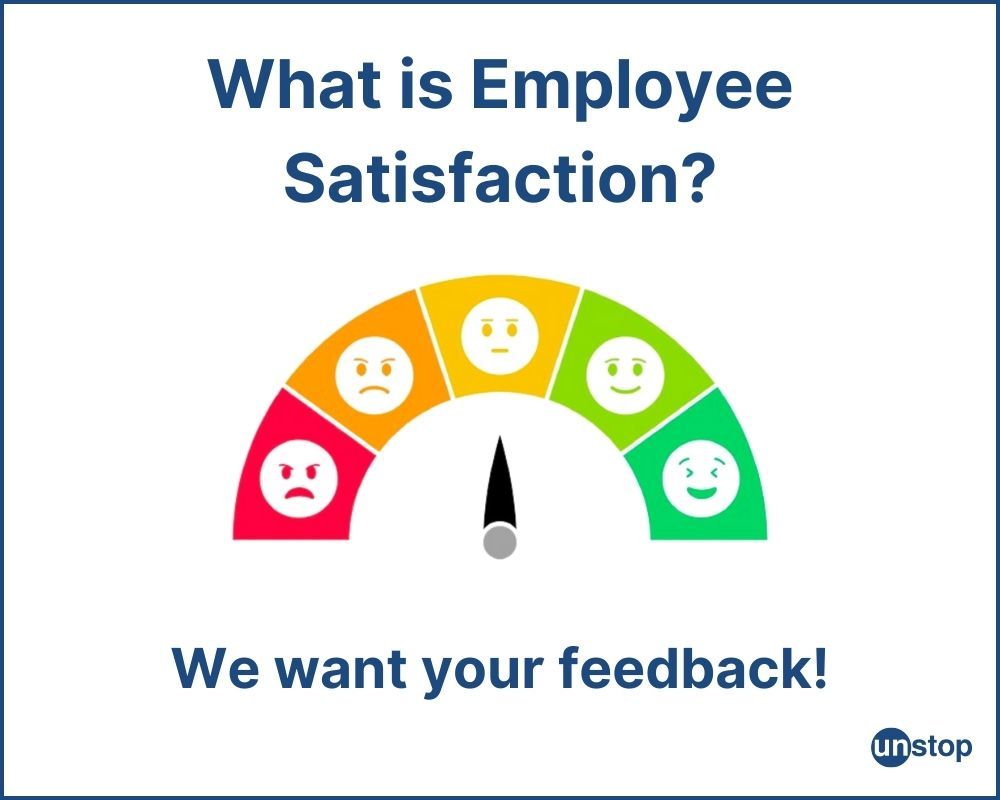
Employee satisfaction refers to the level of contentment and happiness that employees feel towards their job, work environment, and overall experience within an organization.
It encompasses factors such as job security, work-life balance, recognition, compensation, opportunities for growth, and the relationships formed with colleagues and superiors. Employee satisfaction is crucial for employee retention, productivity, and overall organizational success.
Importance of Employee Satisfaction
Here are the five key metrics positively impacted by employee satisfaction:
- Enhanced Customer Service: Engaged and satisfied employees provide better customer experiences, leading to increased customer loyalty and satisfaction.
- Greater Innovation and Creativity: Satisfied employees are more likely to share ideas, contribute to innovation, and develop creative solutions, boosting the organization's competitive edge.
- Attracting and Retaining Top Talent: A positive employer brand built on employee satisfaction attracts and retains high-performing individuals.
- Stronger Financial Performance: Reduced turnover, increased productivity, and improved customer service all contribute to better financial performance and profitability.
- Positive Work Culture: Satisfied employees create a more positive and supportive work environment, attracting and retaining talent and benefiting everyone in the organization.
Beyond these tangible benefits, employee satisfaction fosters a sense of connection, belonging, and ownership within the organization, leading to a more vibrant and resilient workforce.
Objectives of Employee Satisfaction
Building a culture where employees are satisfied translates into several key objectives, namely:
- Work Environment: Employee satisfaction aims to create a positive and supportive work environment where employees feel comfortable, motivated, and valued. This includes factors such as physical workspace, company culture, and relationships with colleagues.
- Recognition and Rewards: Employee satisfaction objectives include acknowledging and rewarding employees for their hard work and achievements. Recognition can boost morale, motivation, and job satisfaction.
- Work-Life Balance: Ensuring that employees have a healthy balance between work and personal life is crucial for their overall satisfaction. This objective focuses on promoting well-being, reducing stress, and improving productivity.
- Growth Opportunities: Employee satisfaction involves providing opportunities for professional development, career advancement, and skill enhancement. When employees see potential for growth within the organization, they are more likely to be satisfied and engaged.
- Honest & Regular Feedback: Employees value feedback on their performance, goals, and areas for improvement. Objective feedback helps employees understand expectations, progress, and areas where they can excel.
- Open Communication: Creating a culture of open communication where employees feel heard, respected, and involved in decision-making processes is essential for employee satisfaction. Transparent communication fosters trust, collaboration, and a sense of belonging within the organization.
Employee Satisfaction vs. Employee Engagement
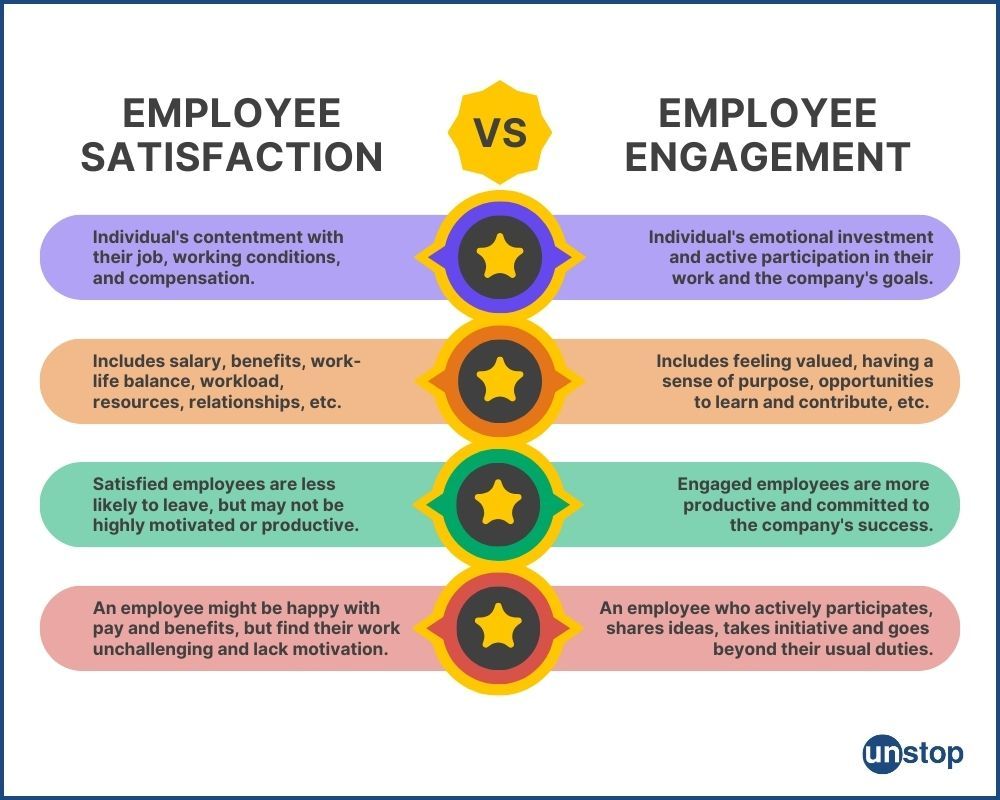
Employee engagement measures emotional commitment and dedication to work, going beyond satisfaction. When employees are engaged, they are more likely to be motivated and enthusiastic about their roles. This leads to increased productivity and better business outcomes as they go the extra mile in their tasks.
For instance, companies like Google focus on engaging employees through various initiatives such as career development opportunities, flexible work arrangements, and recognition programs.
What sets the two apart?
While often used interchangeably, employee satisfaction and employee engagement are two distinct concepts related to workplace experience and well-being.
| Criteria | Employee Satisfaction | Employee Engagement |
| Focus | Refers to an individual's contentment with their job, working conditions, and compensation. | Refers to an individual's emotional investment and active participation in their work and the company's goals. |
| Components | Salary, benefits, work-life balance, workload, resources, relationships with colleagues and managers, and growth opportunities. | Feeling valued, having a sense of purpose, opportunities to learn and contribute, clear communication, recognition for achievements, positive work environment. |
| Impact | Satisfied employees are less likely to leave, but may not necessarily be highly motivated or productive. | Engaged employees are more productive, innovative, and committed to the company's success. |
| Example | An employee might be happy with their pay and benefits, but find their work unchallenging and lack motivation to go above and beyond. | An employee who actively participates in projects, shares ideas, and takes initiative to solve problems, even for tasks beyond their usual duties. |
The key difference between the two is that employee satisfaction is a passive state of contentment, focused on the fulfillment of individual needs. However, employee engagement is about active involvement and contribution, because of a connection to the company's mission and goals.
Ultimately, satisfaction is more about "having" things and engagement is more about "being" and "doing." However, remember - a satisfied employee needs to be engaged to improve overall productivity.
Employee satisfaction is often seen as a foundation for engagement. However, satisfaction alone doesn't guarantee engagement. Strong leadership, meaningful work, and a positive culture can increase both satisfaction and engagement
Find varied solutions to retain and engage top talent on Unstop.
Key Reasons for Employee Dissatisfaction
Lack of Recognition and Appreciation
Employees value recognition and appreciation for their hard work. When they feel undervalued, it can lead to dissatisfaction. Simple gestures like acknowledging achievements or saying thank you can go a long way in boosting morale. Without this recognition, employees may start feeling unappreciated.
Recognition:
- Boosts morale
- Improves motivation
- Enhances job satisfaction
Insufficient Career Growth Opportunities
Career growth is crucial for employee satisfaction. When there are limited opportunities for advancement or professional development, employees may feel stagnant in their roles. Providing avenues for growth such as training programs or promotions can help retain talented staff members.
Career Growth:
- Encourages loyalty
- Fosters skill development
- Increases engagement
Poor Work-Life Balance
Maintaining a healthy balance between work and personal life is essential for employee well-being. Long working hours or unrealistic workload expectations can lead to burnout and dissatisfaction among employees. Offering flexible schedules or promoting time off can help improve work-life balance.
Worklife harmony:
- Increases productivity
- Improves mental health
Strategies for Improving Employee Satisfaction
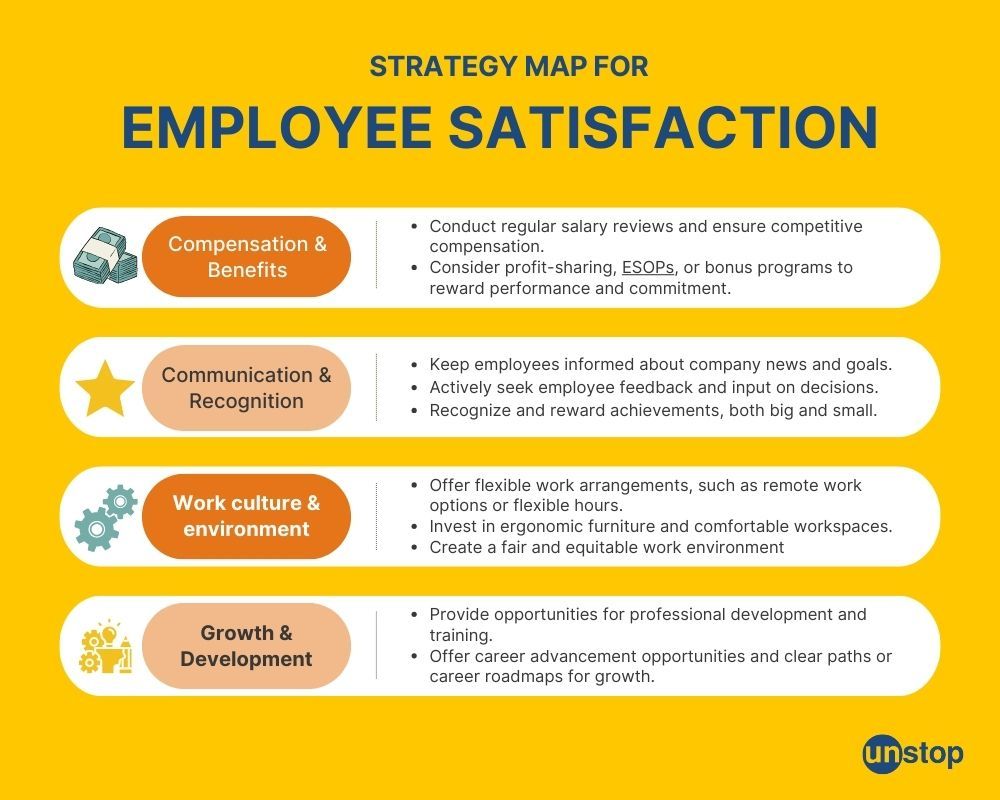
Here are some actionable strategies to improve employee satisfaction:
Compensation & Benefits:
- Conduct regular salary reviews and ensure competitive compensation.
- Offer benefits that employees value, like healthcare coverage and learning opportunities.
- Consider profit-sharing, ESOPs, or bonus programs to reward performance and commitment.
Work Environment & Culture (Well-Being):
- Create a positive and respectful work environment free from discrimination and harassment.
- Promote collaboration and teamwork through team-building activities and recognition programs.
- Invest in ergonomic furniture and comfortable workspaces.
- Offer flexible work arrangements, such as remote work options or flexible hours.
- Promote healthy lifestyles through wellness programs and initiatives.
- Offer paid time off and encourage employees to take it.
- Offer employee assistance programs for those facing personal challenges.
Growth & Development:
- Provide opportunities for professional development and training.
- Offer career advancement opportunities and clear paths or career roadmaps for growth. This includes providing clear information on the expected competencies, output and values required for progression or promotion.
- Offer mentorship programs to help employees develop their skills and careers.
It’s a fact! As per a study by the Robert Walters Group, 69% of millennials stated that career progression keeps them engaged at work.
Communication & Recognition:
- Keep employees informed about company news and goals.
- Actively seek employee feedback and input on decisions. Regular performance feedback provides an opportunity to address concerns constructively and offer guidance for improvement.
- Publicly recognize and appreciate employee achievements. Recognize and reward achievements, both big and small.
- Celebrate team successes and milestones.
Additional Strategies:
- Ease administrative tasks. Wherever possible, ease the process of resolving basic HR and IT queries. Organizations can invest in an internal help center or support tools to resolve common queries.
- Personalize experiences to make employees feel valued. This could include thoughtful gestures like celebrating birthdays and work anniversaries or offering gifts that align with their interests.
- Create an anonymous feedback system for employees to voice concerns.
- Involve employees in decision-making processes whenever possible.
- Practice different types of mentoring, like reverse mentoring or peer-to-peer mentoring. This breaks barriers between the workforce and improves bonding at work.
Ways to Measure Employee Satisfaction
Employee Surveys
Employee surveys are a common method used by companies to gauge employee satisfaction. These surveys can cover various aspects such as career development, work environment, pay, and more. By analyzing the feedback received through these surveys, organizations can identify areas of improvement.
Surveys provide valuable insights into how employees perceive their roles within the company. They can highlight issues related to personalization in the workplace, opportunities for growth and skills development, as well as overall job satisfaction levels.
Learn from example: Questions about job responsibilities and workload can shed light on whether employees feel overwhelmed or adequately challenged.
Turnover Rates
Monitoring turnover rates is another effective way to assess employee satisfaction within a company. High turnover rates may indicate underlying problems such as dissatisfaction with the work environment, lack of career advancement opportunities, or inadequate compensation. On the other hand, low turnover rates suggest that employees are content with their positions and see a future within the organization.
Analyzing turnover data over time allows HR departments and management teams to pinpoint trends and patterns that could impact overall employee morale. By understanding why employees leave or stay with a company, organizations can tailor strategies to enhance employee satisfaction levels effectively.
Best Practices for High Employee Satisfaction
Clear Communication Channels
Establishing clear communication channels is crucial in fostering transparency and trust within the organization. When employees feel informed about company goals, changes, and decisions, it creates a sense of belonging and inclusivity. Open lines of communication can be achieved through regular team meetings and by utilizing tools like intranet platforms or messaging apps.
Avenues for Feedback
Providing avenues for employee feedback is also essential. Surveys, suggestion boxes, or anonymous feedback mechanisms allow employees to express their thoughts freely. This not only helps in addressing concerns promptly but also makes employees feel valued and heard.
Professional Growth Opportunities
Offering opportunities for professional growth through training programs and career advancement initiatives is key to keeping employees engaged and satisfied. Investing in employee development shows a commitment to their success within the organization. Training sessions on new technologies or skills workshops can help enhance job satisfaction levels.
Mentorship Programs
Encouraging mentorship programs where seasoned employees guide newer ones can also foster learning and development. Providing clear paths for career progression motivates employees to strive for excellence.
Final Remarks
Employee satisfaction is crucial for organizational success, directly impacting productivity, retention rates, and overall company performance. By prioritizing employee satisfaction, businesses can create a culture that values and supports their employees, leading to increased motivation, loyalty, and ultimately improved business outcomes.
To ensure long-term success and sustained growth, organizations must continuously evaluate and enhance their approaches to employee satisfaction. Prioritizing employee satisfaction is not just a trend but a strategic imperative for organizations aiming to thrive in today's competitive landscape.
Frequently Asked Questions (FAQs)
1. What is the difference between employee satisfaction and employee engagement?
Employee satisfaction refers to employees' contentment with their job and workplace, while employee engagement reflects their emotional commitment and involvement in the organization's goals. Satisfaction focuses on happiness levels, whereas engagement emphasizes motivation and dedication.
2. Why is understanding employee satisfaction important for businesses?
Understanding employee satisfaction helps businesses improve retention rates, productivity levels, and overall company performance. Satisfied employees are more likely to be motivated, loyal, and productive in their roles, leading to a positive work environment.
3. How can businesses measure employee satisfaction effectively?
Businesses can measure employee satisfaction through surveys, feedback sessions, one-on-one meetings with managers, anonymous suggestion boxes, or utilizing specialized software tools designed for this purpose. Regularly collecting data on various aspects of job satisfaction helps identify areas for improvement, as does analyzing turnover rates.
4. What are some key reasons for employee dissatisfaction in the workplace?
Common reasons for employee dissatisfaction include lack of recognition or rewards, poor communication from management, limited growth opportunities within the company, inadequate work-life balance policies, and unclear expectations or roles at work.
5. What are some strategies that companies can implement to improve employee satisfaction levels?
Companies can enhance employee satisfaction by fostering open communication channels between employees and management, providing opportunities for professional development and career advancement, recognizing employees' contributions through rewards or incentives, promoting a healthy work-life balance culture, and creating a positive organizational climate that values diversity and inclusion.
Suggested Reads:
- Employee Appreciation Quotes: 110+ Messages Celebrating The Workforce
- Team Building Activities For Employees: 45+ Games That Are Actually Fun
- Employee Referral 101: Unlock Benefits, Best Practices & Top Schemes
- Quizzes For Assessment Of Candidates for Upskilling, Promotion, & Hiring
- Live Quizzing vs Treasure Hunt: Choosing What Suits Your Requirements
I’m a reader first and a writer second, constantly diving into the world of content. If I’m not writing or reading, I like watching movies and dreaming of a life by the beach.
Login to continue reading
And access exclusive content, personalized recommendations, and career-boosting opportunities.
Subscribe
to our newsletter
Blogs you need to hog!
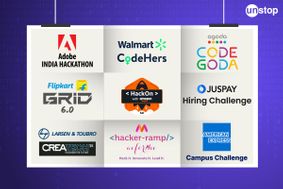
Organize Hackathons: The Ultimate Playbook With Past Case Studies

What is Campus Recruitment? How To Tap The Untapped Talent?
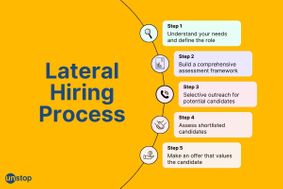
Lateral Hiring: A Complete Guide To The Process, Its Benefits, Challenges & Best Practices
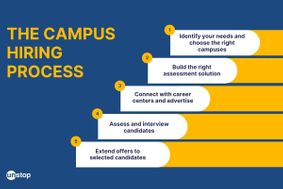












Comments
Add comment